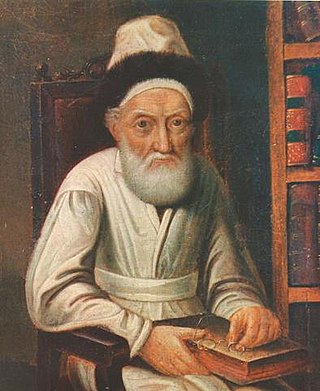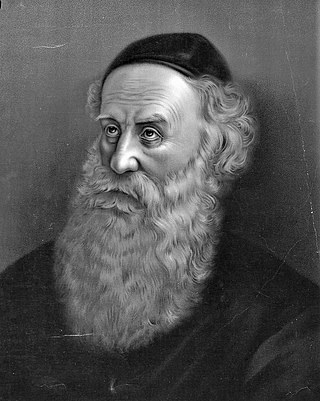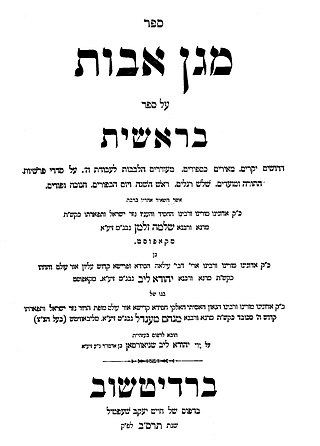
Chabad, also known as Lubavitch, Habad and Chabad-Lubavitch, is an Orthodox Jewish Hasidic dynasty. Chabad is one of the world's best-known Hasidic movements, particularly for its outreach activities. It is one of the largest Hasidic groups and Jewish religious organizations in the world. Unlike most Haredi groups, which are self-segregating, Chabad operates mainly in the wider world and caters to secularized Jews.

Menachem Mendel Schneersohn also known as the Tzemach Tzedek was an Orthodox rabbi, leading 19th-century posek, and the third rebbe of the Chabad Lubavitch Hasidic movement.

Shneur Zalman of Liadi was a rabbi and the founder and first Rebbe of Chabad, a branch of Hasidic Judaism, then based in Liadi in the Grand Duchy of Lithuania and later in the Grodno Governorate of the Russian Empire. He wrote many works, and is best known for Shulchan Aruch HaRav, Tanya, and his Siddur Torah Or compiled according to the Nusach Ari.

Shmuel Schneersohn was an Orthodox rabbi and the fourth Rebbe of the Chabad Lubavitch Chasidic movement.

Schneersohn is a Jewish surname used by many of the descendants of the Rabbi Shneur Zalman of Liadi, the first Rebbe of the Chabad-Lubavitch Hasidic movement.

Shemaryahu Gurary, also known by his Hebrew initials as Rashag, (1897-1989) was a rabbi following the Chabad-Lubavitch dynasty of Hasidism. His father was Menachem Mendel Gurary. He was a son-in-law of Yosef Yitzchok Schneersohn, the sixth Chabad-Lubavitch rebbe, and the brother-in-law of Menachem Mendel Schneerson, the seventh. He worked with his father-in-law in Russia and Poland and moved to the U.S. in 1940.
Mashpia or feminine Mashpi'oh lit. "person of influence", pl. Mashpi'im is the title of a Hasidic rabbi who serves as a spiritual mentor, whose main influence and teachings are in matters of the worship of God, the correction of virtues and spiritual elevation.

The Library Of Agudas Chassidei Chabad is a research library owned by Agudas Chasidei Chabad. Its content had been collected by the Chabad-Lubavitch Rebbes. The library is housed next to the Lubavitch world headquarters at 770 Eastern Parkway in Brooklyn, New York, and is utilized by Chabad and general Judaic scholars. It is viewed by thousands of visitors each year.

Yehuda Leib "Leibel" Groner was an American Hasidic Jewish teacher, scholar, and author. He is best known for having served as the personal secretary to Rabbi Menachem Mendel Schneerson, the seventh Lubavitcher Rebbe, for 40 years.

Rabbi Yehuda Leib Schneersohn (1808-1866) was a Ukrainian Habad Hasidic rabbi, the second son of Menachem Mendel Schneersohn, and founder and first leader of Kopust Hasidism.

Shlomo Schneur Zalman Schneersohn was a Ukrainian Habad Hasidic rabbi who was the second leader of Kopust Hasidism from 1866 to his death in 1900.

Shmaryahu Noah Schneersohn (1842-1923) was the fourth and last rebbe of Kopust, a branch of the Chabad dynasty of Hasidism. He succeeded as 4th leader of the group after his brother, Shalom Dovber Schneersohn, died. Other sources say he succeeded his brother, Shlomo Zalman Schneersohn, as leader of the group in the year 1900 after Shlomo Zalman died. He served as the Kopuster movement's rebbe in the town of Babruysk. He was rabbi of the chasidim in Babruysk from 1872, and founded a yeshiva there in 1901. He authored a two-volume work on Hasidism, titled "Shemen LaMaor".

Chabad offshoot groups are those spawned from the Chabad Hasidic Jewish movement. Many of these groups were founded to succeed previous Chabad leaders, acting as rivals to some of the dynastic rebbes of Chabad. Others were founded by former students of the movement, who, in forming their own groups, drew upon their experiences at Chabad.

Rabbi Yitzchak Dovber Schneersohn of Liadi (1833-1910), was a Hasidic rebbe in the town of Liadi. Rabbi Yitzchak Dovber was the son of Rabbi Chaim Schneur Zalman of Liadi. Rabbi Yitzchak Dovber succeeded his father as rebbe for a number of Chabad Chasidim in Lyady. His brother-in-law, Rabbi Levi Yitzchak became a rebbe in the town of Sirotin (Siratshin). He and his brother-in-law were the last rebbes of the Liadi branch of Chabad.

Chabad philosophy comprises the teachings of the leaders of Chabad-Lubavitch, a Hasidic movement. Chabad Hasidic philosophy focuses on religious concepts such as God, the soul, and the meaning of the Jewish commandments.

Chabad customs and holidays are the practices, rituals and holidays performed and celebrated by adherents of the Chabad-Lubavitch Hasidic movement. The customs, or minhagim and prayer services are based on Lurianic kabbalah. The holidays are celebrations of events in Chabad history. General Chabad customs, called minhagim, distinguish the movement from other Hasidic groups.

Yom Tov Shel Rosh Hashana: 5666, known in Chasidic reference as Samech Vov, is a compilation of the Chasidic treatises by Rabbi Sholom Dovber Schneersohn, the fifth Rebbe of Chabad, from the Hebrew year 5666 (1905–06). This series of Chassidic essays is considered a fundamental work of Chabad mysticism. The Samech Vov series is one of the single largest works of Chabad philosophy. The work is titled as Yom Tov Shel Rosh Hashana after the opening words of the first treatise. The work is also referred to as Hemshech Samech Vov.
Chaya Mushka Schneersohn was the daughter of Rabbi Dovber Schneuri, the second Rebbe of the Chabad Hasidic movement, and the wife of Rabbi Menachem Mendel Schneersohn the third Rebbe.
Shaina Horenstein was the youngest daughter of Rabbi Yosef Yitzchak Schneersohn, the sixth Rebbe of the Chabad Hasidic movement. In the Chabad community, she is referred to as Rebbitzin Shaina.

Hasidic Judaism in Lithuania is the history of Hasidic Judaism and Hasidic philosophy in Lithuania and parts of modern-day Belarus. Hasidic Judaism in Lithuania began with R. Aaron Perlow of Karlin (Karalin) (1736–1772), R. Menachem Mendel of Vitebsk (1730?–1788) R. Shneur Zalman of Liadi (Lyady) (1745–1812) and to a lesser extent R. Hayim Haykl of Amdur (Indura), all of whom were disciples of R. Dov Ber of Mezeritch (Mezhirichi), who in part was the successor to the R. Israel Baal Shem Tov who founded Hasidic Judaism in Western Ukraine. In its earliest years, Lithuanian Hasidism suffered immense persecution by the Lithuanian Misnagdic rabbinate, who attempted to ban and excommunicate Hasidism on several occasions in Lithuania beginning with R. Elijah b. Solomon Zalman of Vilna (1720–1797), who was the earliest disseminator of anti-Hasidic thought which flourished in Lithuania.














